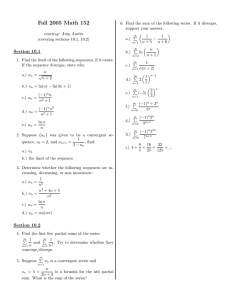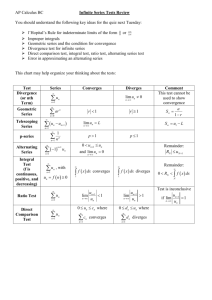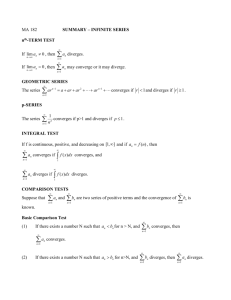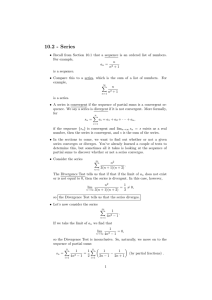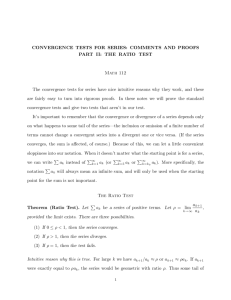SERIES courtesy of Amy Austin Def: Let {a } = {a
advertisement
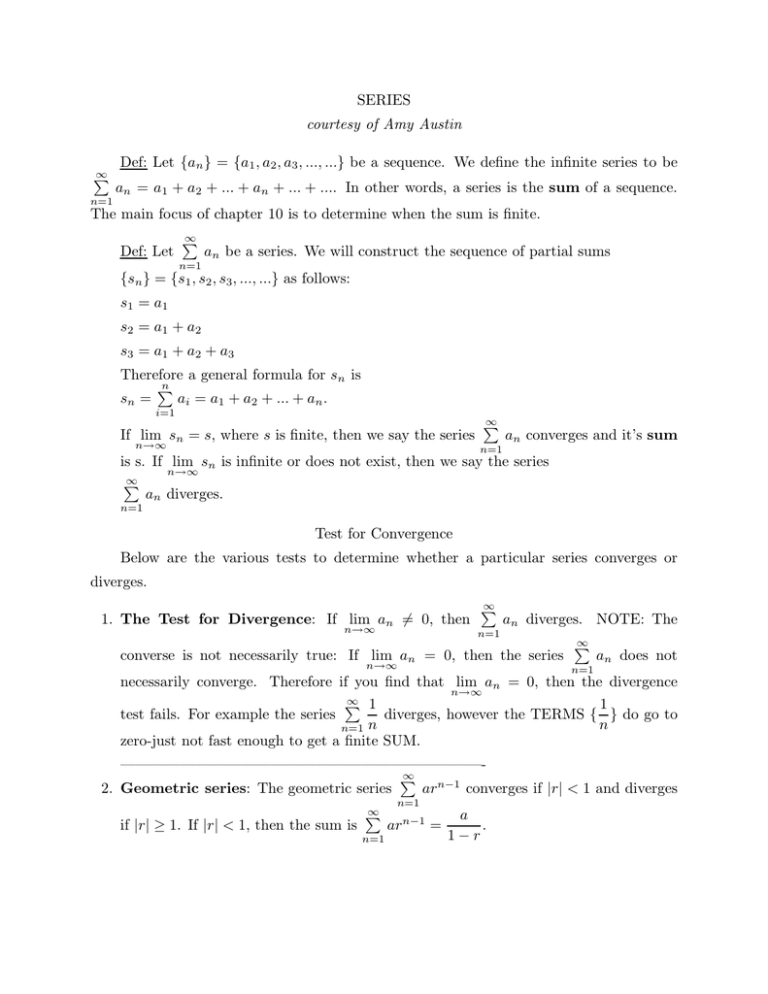
SERIES
courtesy of Amy Austin
Def: Let {an } = {a1 , a2 , a3 , ..., ...} be a sequence. We define the infinite series to be
∞
P
an = a1 + a2 + ... + an + ... + .... In other words, a series is the sum of a sequence.
n=1
The main focus of chapter 10 is to determine when the sum is finite.
Def: Let
∞
P
an be a series. We will construct the sequence of partial sums
n=1
{sn } = {s1 , s2 , s3 , ..., ...} as follows:
s1 = a1
s2 = a1 + a2
s3 = a1 + a2 + a3
Therefore a general formula for sn is
n
P
ai = a1 + a2 + ... + an .
sn =
i=1
If lim sn = s, where s is finite, then we say the series
n→∞
∞
P
an converges and it’s sum
n=1
is s. If lim sn is infinite or does not exist, then we say the series
n→∞
∞
P
an diverges.
n=1
Test for Convergence
Below are the various tests to determine whether a particular series converges or
diverges.
1. The Test for Divergence: If lim an 6= 0, then
n→∞
∞
P
an diverges. NOTE: The
n=1
converse is not necessarily true: If lim an = 0, then the series
n→∞
∞
P
an does not
n=1
necessarily converge. Therefore if you find that lim an = 0, then the divergence
n→∞
∞ 1
P
1
test fails. For example the series
diverges, however the TERMS { } do go to
n
n=1 n
zero-just not fast enough to get a finite SUM.
————————————————————————∞
P
2. Geometric series: The geometric series
ar n−1 converges if |r| < 1 and diverges
n=1
if |r| ≥ 1. If |r| < 1, then the sum is
∞
P
n=1
ar n−1 =
a
.
1−r
3. The Integral Test: If f (x) is a positive, continuous, decreasing function on [1, ∞],
and an = f (n). Then:
Z ∞
∞
P
a.) If
f (x) dx is convergent, then
an converges.
n=1
1
Z ∞
∞
P
b.) If
f (x) dx diverges, then
an diverges.
n=1
1
————————————————————————∞ 1
P
is convergent if p > 1 and divergent if p ≤ 1
4. The p-series
p
n=1 n
————————————————————————–
5. The Comparison Test: (Use this test if the series is a series of positive terms, and
the series is comparable to a p-series or a geometric series.)
∞
∞
P
P
Suppose
an and
bn are series of positive terms.
n=1
a.) If
b.) If
∞
P
n=1
∞
P
i=1
bn is convergent and an ≤ bn for all n, then
bn is divergent and an ≥ bn for all n, then
n=1
∞
P
an is also convergent.
n=1
∞
P
an is also divergent.
n=1
————————————————————————–
6. The Limit Comparison Test: Conditions for using this test are the same conditions
as the comparison test.
∞
∞
P
P
Suppose
an and
bn are series of positive terms.
n=1
n=1
an
= c > 0, then either both series converge or both diverge.
a.) If lim
n→∞ bn
————————————————————————–
∞
P
7. The Alternating Series Test: If the alternating series
(−1)n an satisfies
n=1
a.) an+1 ≤ an for all n (ie the sequence {an } is decreasing).
b.) lim an = 0
n→∞
then the series converges.
8. The Ratio Test: (Use this test if the series contains n! or numbers raised to the nth
power, such as 2n . If the ONLY number raised to the nth power is (−1)n , then use
the alternating
test).
series
∞
an+1 P
= L < 1, then the series
an is absolutely convergent (and
a.) If lim n→∞
an
n=1
therefore convergent).
∞
an+1 an+1 P
= ∞, then the series
b.) If lim =
L
>
1
or
lim
an is divergent.
n→∞
n→∞ an an n=1
an+1 = 1, then the test fails.
c.) If lim n→∞
an —————————————————————
9. Remainder formulas:
• The Remainder Estimate for the Integral test: Suppose
∞
P
an is a series
n=1
which was shown to be convergent as a result of the integral test or a comparison test.
∞
P
This means that the sum of the series is finite. Let’s say
an = s. Suppose further that
n=1
I used a partial sum sn =
n
P
ai = a1 + a2 + ... + an to approximate s. Then the remainder
i=1
is defined to be Rn =
∞
P
ai = an+1 + an+2 + ... + ....
i=n+1
a.) If we want
to get an upper bound for the error in using sn to approximate s, then
Z
∞
Rn ≤
f (x) dx.
n
If we want to getZan interval on which the remainder lies, then
Zb.)
∞
∞
f (x) dx ≤ Rn ≤
f (x) dx.
n+1
n
• The Alternating Series Theorem: If
∞
P
(−1)n an is a convergent alternating
n=1
series, and I used a partial sum sn =
n
P
i
(−1) ai to approximate the sum, then an upper
i=1
bound on the absolute value of the remainder is |Rn | ≤ an+1 .

